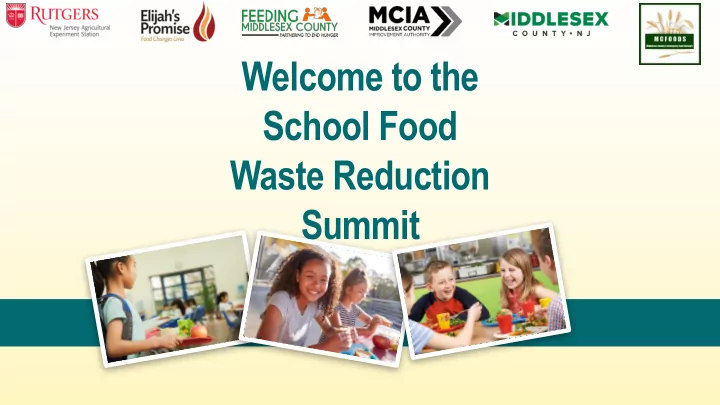

Welcome to the School Food Waste Reduction Summit
Welcome Dr. Brian Schilling, PhD • Director, Rutgers Cooperative Extension • Senior Associate Director, NJ Agricultural Experiment Station
Food Insecurity & Food Waste Dr. Shilpa Pai, MD • Director, Resident Education in Advocacy & Community Health • Co-Director, NJ Pediatric Residency Advocacy Collaborative • AAP District III Community Access to Children's Health (CATCH) Facilitator • Associate Professor of Pediatrics, Department of Pediatrics, Rutgers- Robert Wood Johnson Medical School
Case Study: Paterson, NJ Sara Elnakib, RD, MPH Family & Community Health Sciences Educator, Rutgers University
The Facts about Food Waste ⊷ Approximately 30 to 40 percent of the food supply, ends up as food waste. ⊷ In 2010, an estimated 133 billion pounds of food from U.S. retail food stores, restaurants, and homes – valued at approximately $161 billion – went uneaten . ⊷ The land, water, labor, energy and other inputs used in producing, processing, transporting, preparing, storing, and disposing of discarded food is wasted. ⊷ In 2010, the bill for dumping food into landfills was more than $2 billion. Source: https://www.usda.gov/oce/foodwaste/sources.htm
USDA & EPA Food Waste Challenge “ On September 16, 2015, the first-ever national food loss and waste goal in the United States was launched, calling for a 50- percent reduction by 2030. 6
“ 7 Source: Emily DeMaio, NJDEP Emily.DeMaio@dep.nj.gov
“ 8 Source: Emily DeMaio, NJDEP Emily.DeMaio@dep.nj.gov
The Guidelines for Schools ⊷ The NJDEP will be releasing the Food Waste Guidelines for both K-12 schools and Higher Education. ⊷ To achieve the goals of Bill S3027 we need to measure baseline food waste. 9
How to Reduce Food Waste? 10
Paterson’s Food Waste Program • Through a partnership with the Paterson Public Schools we conducted an audit to assess the effect of training for Food Service Workers on food waste. • Paterson Public Schools is under the Community Eligibility Provision • All students receive free Breakfast & Lunch 11
Design of this Study ⊷ We wanted to measure the plate waste before and after the training. We only measured 15 elementary and middle schools that cooked their own meals. ⊶ Sample tray were weighed as a pre- consumption measure. ⊶ After the food was consumed each food component was weighed separately separately. (fruits, vegetables, milk and entrée [grain/protein]) ⊶ Each school was measured twice before and after the training.
Training Program ⊷ Smarter Lunchrooms Movement ⊷ Offer Vs. Serve 13
Smarter Lunchrooms Movement • In the language of behavioral economics, these • The Cornell B.E.N. Center researches how factors are called Visibility and Convenience, and they influence consumers’ choices. behavioral economics influences students’ food choices. • Most choices are so subliminal they seem • Make healthy choices visible, convenient, and automatic appealing to students • Choices influenced by environment • Change your environment = Change your habits. 14
Examples of Smarter Lunchroom Strategies • Focus on Fruits • Move More White Milk • At least two kinds of fruit are offered. • White milk is displayed in front of other beverages in • Sliced or cut fruit is offered. all coolers. • 1% or non-fat white milk is identified as the featured milk and is labeled with a creative, descriptive name. • Vary the Vegetables • Both hot and cold vegetables are offered. • Lunchroom Atmosphere • When cut, raw vegetables, are offered, they are paired with a low-fat dip such as ranch, • Attractive, healthful food posters are displayed in hummus, or salsa. dining and service areas. • Cafeteria staff smile and greet students upon entering the service line and throughout meal service. • Highlight the Salad • Pre-packaged salads or a salad bar is available to all students. • Pre-packaged salads or a salad bar is in a high- traffic area. 15
Offer vs. Serve • According to guidelines by the USDA, students do not need to take all 5 components of a meal for the school to be reimbursed for that meal. • A student may choose 3 our of the 5 components at lunch and the school will be reimbursed as long as the student takes a fruit or vegetable.
Food Waste-Pre Intervention 902 pounds of waste 530 pounds of waste 570 pounds of waste 471 pounds of waste
2,473 pounds Wasted in our 30 visits in schools 18
What does this mean? ⊷ That is approximately 84 pounds of waste per school per day ⊷ Which means it can be as much as 14,838 pounds of waste a year per school. ⊷ 623,196 pounds of food waste for the whole district for the year.
Food Waste: Post-Intervention 804 pounds of waste 380 pounds of waste 10% of Milk 28% of Fruit Saved Saved (98 lbs) (150 lbs) 490 pounds of waste 449 pounds of waste 14% of Vegetables 5% of Grain & Protein Saved Saved (22 lbs) (80 lbs)
350 pounds of food saved after our training 21
What does this mean? ⊷ That is approximately 12 pounds of waste SAVED per school per day ⊷ Which means it can be as much as 2,160 pounds of waste SAVED a year per school. ⊷ 90,720 pounds of food waste SAVED for the whole district for the year.
$76,452 cost savings for the school district per year 23
Panel Discussion Dr. Shilpa Pai Jennifer Apostol Jennifer Shukaitis David Buchholtz Director, Resident Education Family & Community Director of MCFOODS Director of Food Services, in Advocacy & Community Health Sciences Health, Paterson Public Schools Educator, Rutgers-Robert Wood Rutgers University Johnson Medical School
School Food Waste Design-a-thon
Thank You
Recommend
More recommend